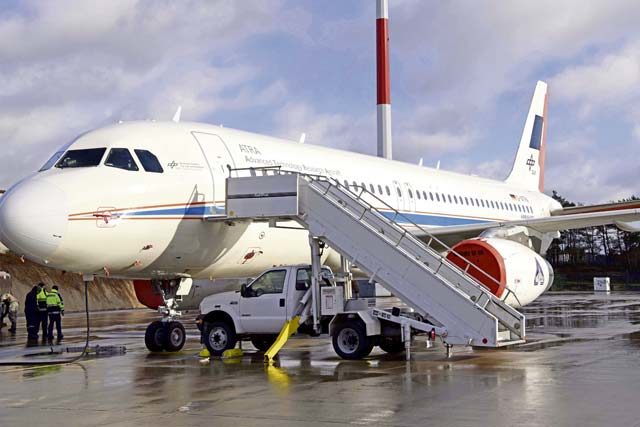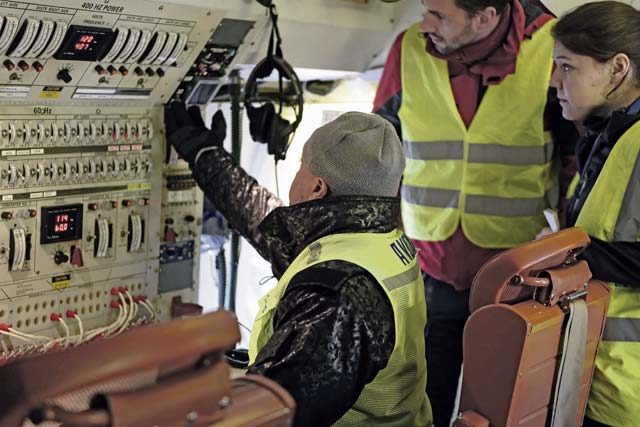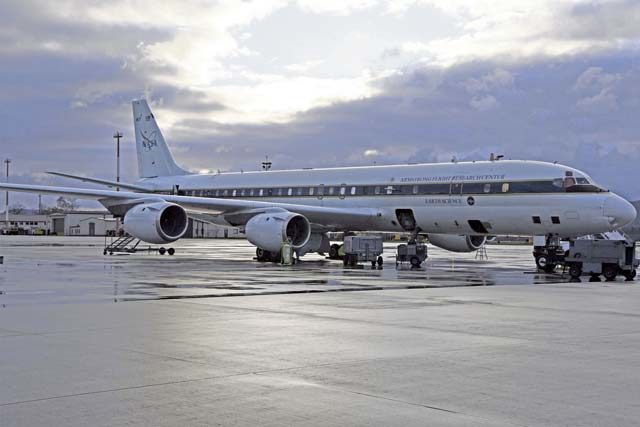
The National Aeronautics and Space Administration along with the German Aerospace Center, or DLR, conducting biofuel testing over the skies of Germany this month.
Temporarily stationed at Ramstein, NASA Armstrong Flight Research Center’s DC-8 jetliner was accompanied by the DLR’s Advanced Technology Research Aircraft, an A320, to study the effect of fuel composition on contrail formation.
“Contrails are ice clouds that form in the exhaust of aircraft flying at higher altitudes where the temperatures are very cold,” said Bruce Anderson, aerospace technologist, Science Mission Directorate at NASA Langley Research Center. “The ice particles condense on soot that comes out of engines.”
The contrails generated by aircraft are a concern to the environment because they trap heat; they make the surface of the earth warmer at night, said Anderson.
“We’ve learned by burning cleaner fuels, we can reduce the cover of the extensive clouds that form behind aircraft,” Anderson said. “The composition of fuel kind of regulates the amount of soot particles that form.”
Anderson said they can decrease the amount of soot particles by 50 to 90 percent, depending on what fraction of clean biofuels they mix with the standard jet fuel.
The DLR’s D-ATRA Airbus A-320 burned the standard jet fuel with a 50 percent biofuel mix while NASA’s DC-8 flying laboratory flew behind it to measure the composition of its exhaust and the number and size of the ice particles that were left in the contrails.
“We have three different fuels and plan on doing two flights per fuel,” Anderson said.
“We are also surveying emissions from other aircraft that are flying out of Frankfurt. We have a total of 50 flight hours. Ten hours will be devoted to surveying contrails, emissions and flight corridors over Germany, while the remaining 40 hours will be used in having the DC-8 fly behind the A-320 in mostly reserved airspace.”
The biofuels as well as the standard jet fuel were provided by the DLR.
There’s a general push to reduce the environmental impact of the energy sector, both in ground-base and airborne transportation. These areas create a lot of carbon dioxide, which is a greenhouse gas, Anderson said.
“There’s an international interest to reduce carbon dioxide emissions,” Anderson said. “The only way to do that is to burn renewable fuels.”
Standard jet fuel has multiple contaminants. The biofuels being tested are simpler compounds and burn much cleaner, Anderson said.
“You can regrow the biofuel and form a close cycle, where you’re not depleting resources or generating a lot of carbon dioxide, plus you reduce soot emissions,” said Anderson.
Ramstein provided NASA and the DLR with supplies to maintain their planes, as well as a place to secure them and a runway to take off from.
“Historically, we’ve had very good support conducting investigations out of air bases,” said Anderson. “This aircraft that we have is highly instrumented, and we really like the security we get from operating out of Ramstein.”
It was the DLR’s first time working with the United States Air Force.
“We’ve received amazing support from the personnel here at Ramstein,” said Patrick le Clercq, department head at German Aerospace Center, Institute of Combustion Technology.
“It’s been very good to work with the different people here,” le Clercq said. “Everyone’s made themselves available and have shown a lot of interest in our work.”
Overall, if this joint international venture can help to reduce contrails and produce less soot, it’ll be a significant benefit to the environment.




